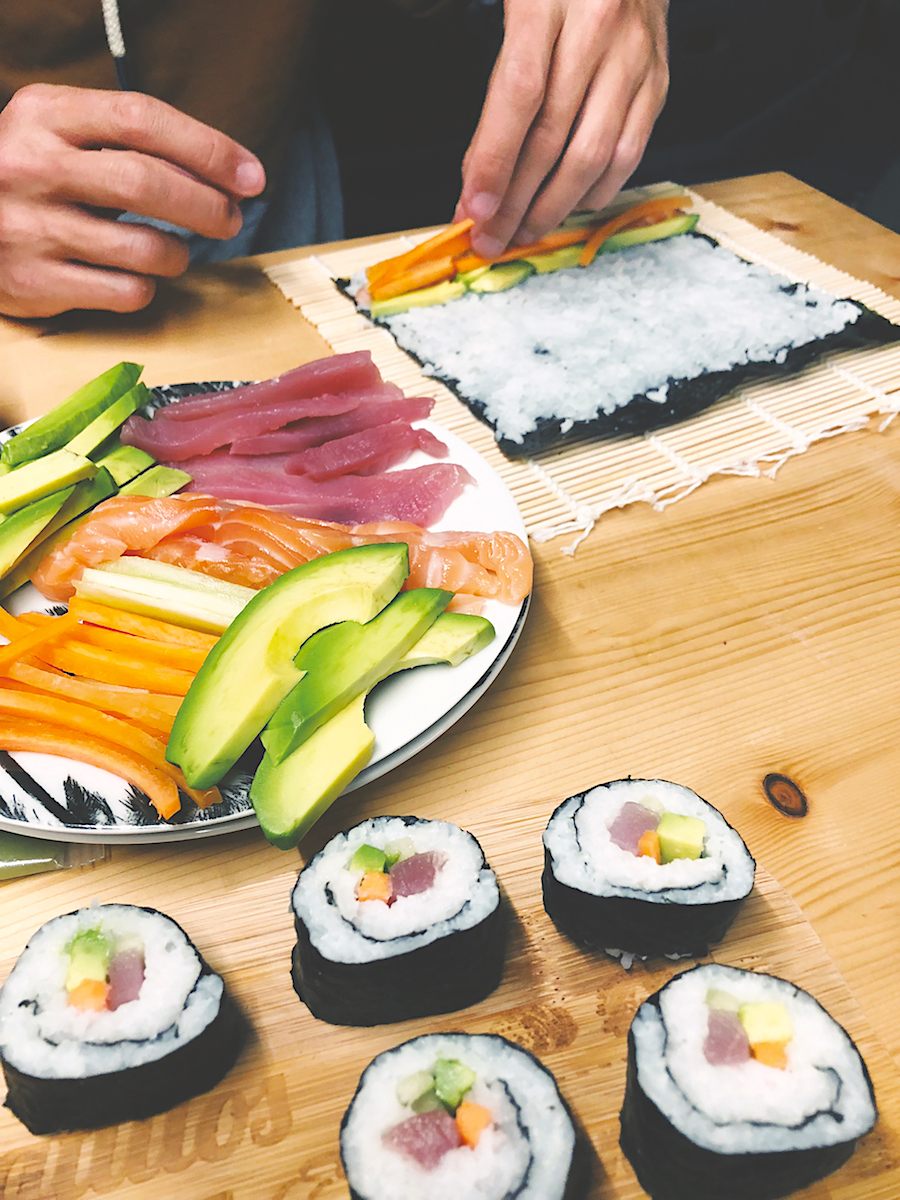We lived in Japan for 10 years, and that is where we whetted our taste for sushi. For 20 years now we have lived on Cape Cod, and making sushi at home is a favorite meal in our household, both for family and for company.

When friends from Japan come to visit, they rave about the quality of the fish in our local markets, which they call kinkaimono, meaning “from nearby waters.” This is a special treat for them because most fish eaten in Japan has been frozen for at least part of its trip to the table.
Even so, most of our Cape Cod friends shy away from making sushi at home. They think it must be hard to do and expensive. Nothing could be further from the truth. Although you do need to lay in a few special ingredients, sheets of dried nori seaweed, rice wine vinegar, soy sauce, wasabi, and pickled ginger are now readily available in regular supermarkets. And you do not need great quantities of the fish, vegetables, and fruits that will be the stars of your show. If you figure on even a quarter pound of fresh fish per person, you are sure to have leftovers.
The most important thing is to deal with a fish market where they know what they are doing, someone you trust.
Our favorite ingredients are raw tuna and scallops, to which we add avocados, cucumbers, and sometimes daikon white radish and mango. We set out the ingredients so everyone at the table can choose what they like. You can prepare your sushi by rolling it up or skip that and just put the rice in individual bowls and arrange the fish on top.
Let’s dispense with another misapprehension: the word “sushi” does not mean “raw fish.” It means “rice with vinegar.” Everything else is bonus. It’s good to use a Japanese short grain rice such as Kokuho Rose, which comes from California. If you want to use brown rice, make sure it’s short grain, which has the right stickiness.
Cook the rice in your usual way, whether on the stove top or in a rice cooker. When it is done, and while it is still very hot, add some rice vinegar — a tablespoon or so per person, just enough to give the rice a tart note. A little salt and sugar in the rice is also traditional. Put the rice in a big bowl and let it cool to skin temperature. Drape a dampened cloth over the rice to keep it from drying out.
Meanwhile, you’ve gone to the fish market. The fish should be very fresh, but it need not have been caught that day. We learned from the film Jiro Dreams of Sushi that sushi shops in Japan actually age their fish for up to a week or so. Here, we tell the people at our local fish market that we are planning to eat the fish raw and they tell us what’s best that day.
Beyond the tuna and scallops that are our mainstays, flounder is nice when you can get it, and so is raw salmon, but you can also use smoked salmon. Cooked shrimp and lobster meat are also nice. “Spicy tuna roll” is not a traditional Japanese thing, but you can make it by mincing raw tuna and mixing it with mayonnaise and hot sauce.
When you pair the fish with vegetables and fruits, the only limitation is your own imagination, and what you find in the market. Cut the fish as well as the cucumbers, mango, or what-have-you into thin strips, mix up some wasabi, and you’re ready to roll.
Sushi at Home
to make enough for six people
1 to 1.5 lbs. fresh fish, scallops, cooked shrimp or lobster (in any combination)
4 cups cooked short grain rice, still slightly warm
4 to 6 tbsp. rice wine vinegar
1 tsp. sugar (optional)
Salt to taste (optional)
12 sheets of nori dried seaweed
A handful per person of sliced avocado, daikon radish, cucumber, mango, or whatever else is suitable and available
Season with soy sauce and wasabi to taste.
Spread some seasoned rice on a sheet of seaweed. We use a bamboo paddle to do this, but you can use your hands—just wet them to keep the rice from sticking. Then lay on the fish and vegetables. To get the rolls to work, it’s important not to overstuff!
Now roll the sushi into cylinders. A bamboo mat is helpful for keeping the roll tightly wrapped, but if you don’t have one, you can improvise using plastic wrap or waxed paper. Then slice into pieces and admire your handiwork.
An alternative is to roll your sushi into cone shapes (called temaki, meaning “hand rolls”). Even easier: just put the rice in a bowl with the goodies on top (this is called chirashi or kaisendon), or serve the ingredients as sashimi, sliced on individual plates, with a bowl of rice on the side.
It’s best to eat each roll while the nori is still crisp, and the rice is still warm. Enjoy your sushi with a quick dip of soy sauce, with maybe some wasabi mixed in, and pickled ginger (gari) on the side.
Elaine Lipton contributed to this article.
